You want a regional specialty from Thuringia? Then I have just the right thing for you today!
I’ll show you how you can make a “Thüringer Bratwurst” -> German for “Thuringer Sausage” yourself. Delicious!
You will find a complete list of ingredients, materials and a simple recipe that you can copy immediately.
Thüringer Bratwurst is easy and quick to make. So perfect for beginners. The preparation takes about 45 minutes.
But enough talking now. You can watch the complete instructions either via video or read them here. I wish you a lot of fun and good luck!
Table of Contents
Thuringer Sausage – What do you need to make it?
Important: Thüringer Rostbratwurst is a regional Thuringian specialty and protected by EU regulation.
According to this regulation, it is at least 15 cm long, medium-fine and in a narrow natural casing (pork or sheep gut), raw (for immediate consumption) or scalded and has a hearty, savory taste.
The ingredients are described as follows: coarsely defatted pork, pork cheeks without rind, possibly stretched veal or beef for the sausage meat, not reddened; the spice mixtures vary according to the handed-down recipe or regional characteristics; in addition to salt and pepper, caraway, marjoram and garlic are used in particular.
Because there are so many different recipes, I have added 3 more recipes at the end of the article.
But now to my recipe…
Ingredients for your thuringian sausage
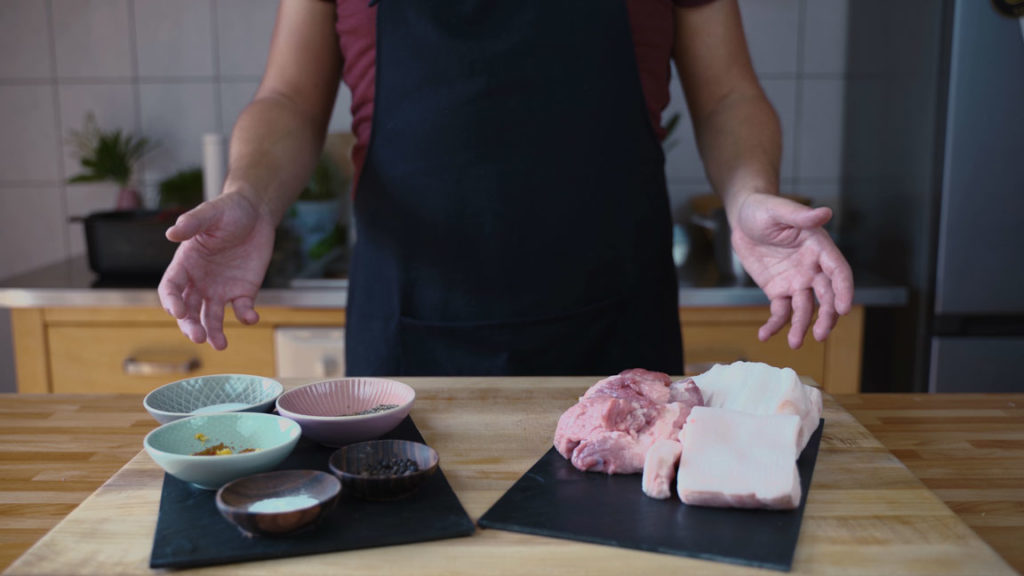
Meat (1000 g):
- 50 % pork belly (500 g)
- 30 % pork shoulder (300 g)
- 20 % pork backfat (200 g)
Also, an additional 15 -20 % crushed ice (150 – 200 g)
Spices per 1000 g of meat:
- 20 g salt
- 4 g caraway
- 3 g marjoram
- 3 g Cutter Phosphate (e.g. BRIFISOL 414, PhosThis!, Ames Phos)
- 3 g black pepper
- 2 g mace
- 1 g paprika
- 1 g allspice
- 1 g lemon zest
The equipment to make Thuringer sausage
You need a meat grinder to “grind” the meat. The grinder chops the meat into small chunks which then can then be mixed.
If you want to grind your spices The spice mill grinds the spices while the mortar crushes or grinds the spices.
Food Processor / Thermomix / Sausage Cutter
The texture of this sausage is very fine. Therefore, you need a food processor or dedicated machine to cut the meat mixture as fine as possible.
You need a sausage stuffer to get your meat mass into the casing. If you are starting out you can also add an attachment to your grinder or use a modified plastic bottle or funnel.
Sausage casings
Thuringer Sausage is traditionally filled into natural casings.
I recommend hog casings caliber 28 / 30. If you like to make thinner sausages, sheep casings caliber 20/22 are very good.
If you would like to prepare the sausages without casing: You can just form the mass into patties and fry them out without a casing or preserve them in a jar.
Make Thuringer Sausage – Step-By-Step Instructions
1. Cut the pork shoulder, belly and backfat into strips which can fit into your grinder.
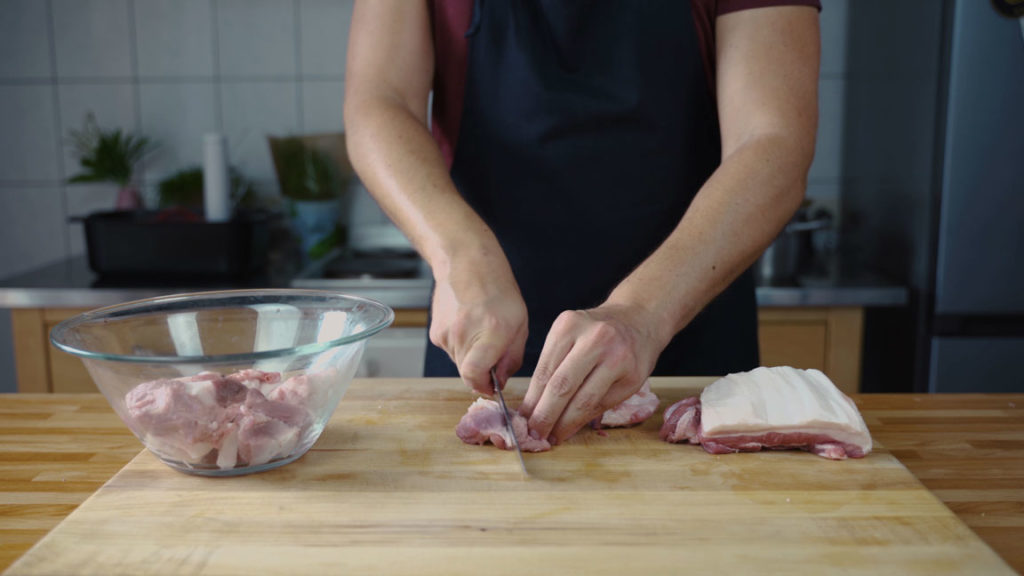
2. Grind the spices and salt with a spice grinder. This will yield a super fine mixture which will distribute evenly across the meat.
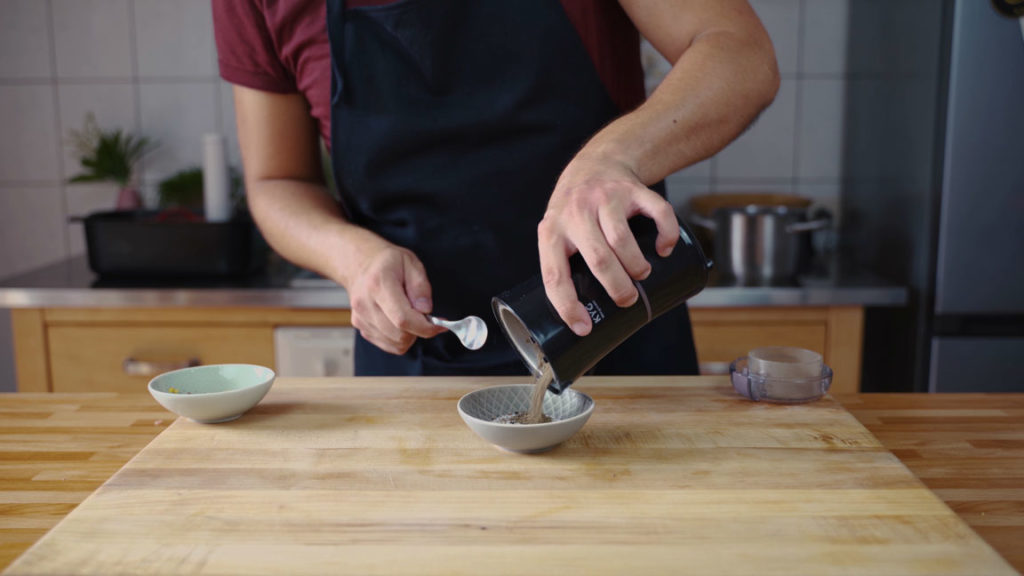
3. Add the spices to the meat and mix the ingredients. Put the meat and the movable parts of your grinder into the freezer for 1 – 2 hours. This will help with the grinding process and the meat temperature.
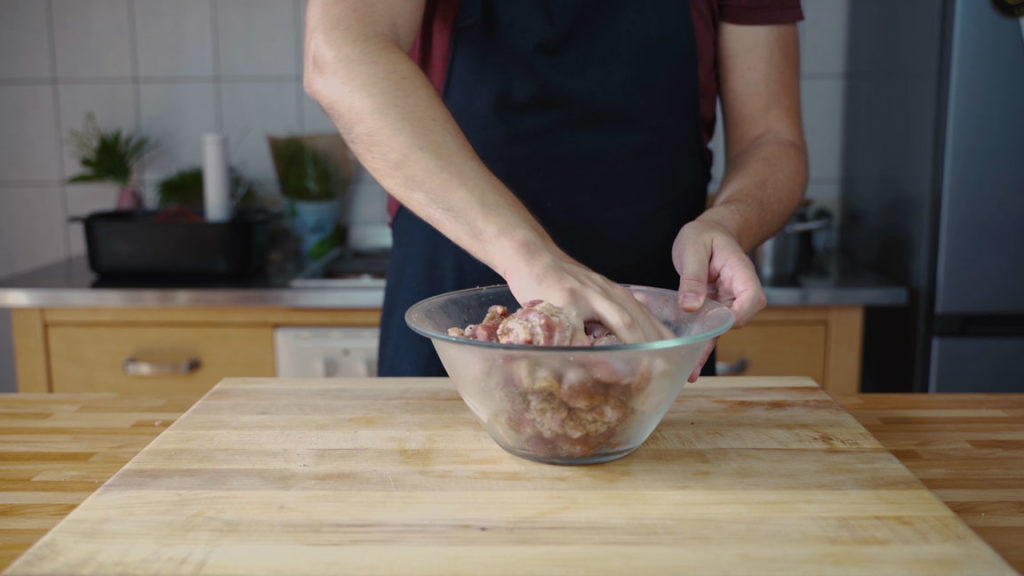
4. Now it’s time to grind the meat. Grind the meat through the finest perforated disc (2mm). You can grind it twice. The next step will be easier this way.
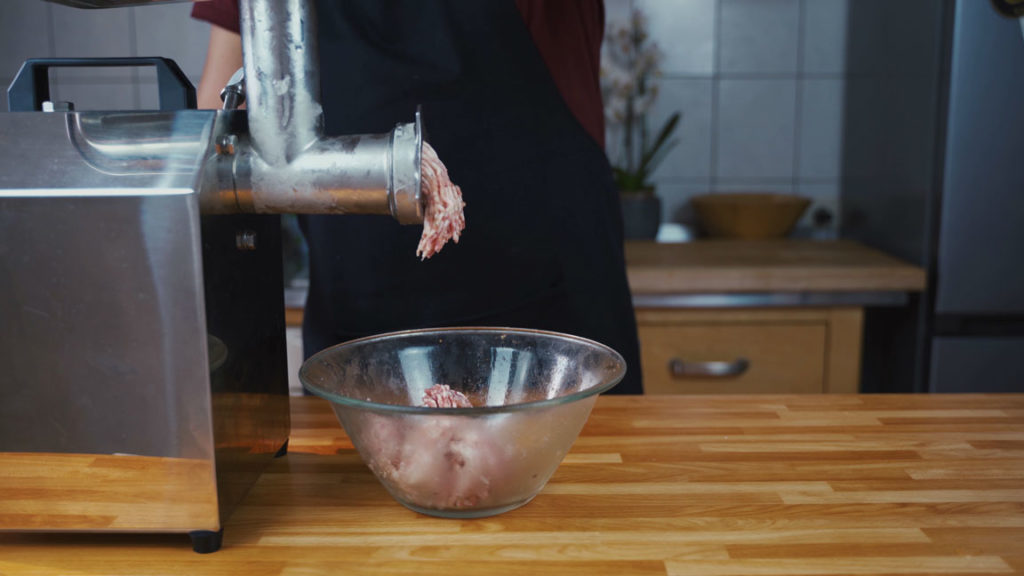
5. Now add the minced meat together with the salt and the curing aid to the food processor. Now mix the ingredients until they form a fine cohesive mass.
Gradually add the crushed ice as you process it. The temperature should be below 12 °C (53,6 °F) at all times.

6. Put the casing onto the sausage stuffer. Typically, you need to put the casings into a lukewarm water 30 min before you use them. This will ensure that they can be put onto the stuffer.
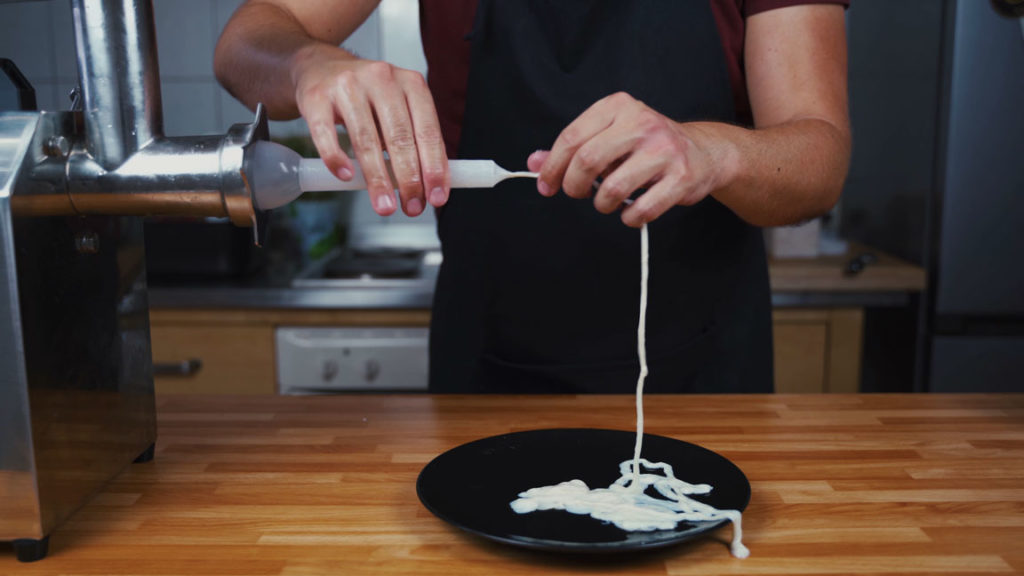
7. Fill the meat into the casing. Hold the casing tightly on the filling spout and let it slowly fill up more and more. This part needs some practice. Do not worry if it does not work 100%.
Important: Do not fill the casing too full, otherwise it will burst later when roasting.
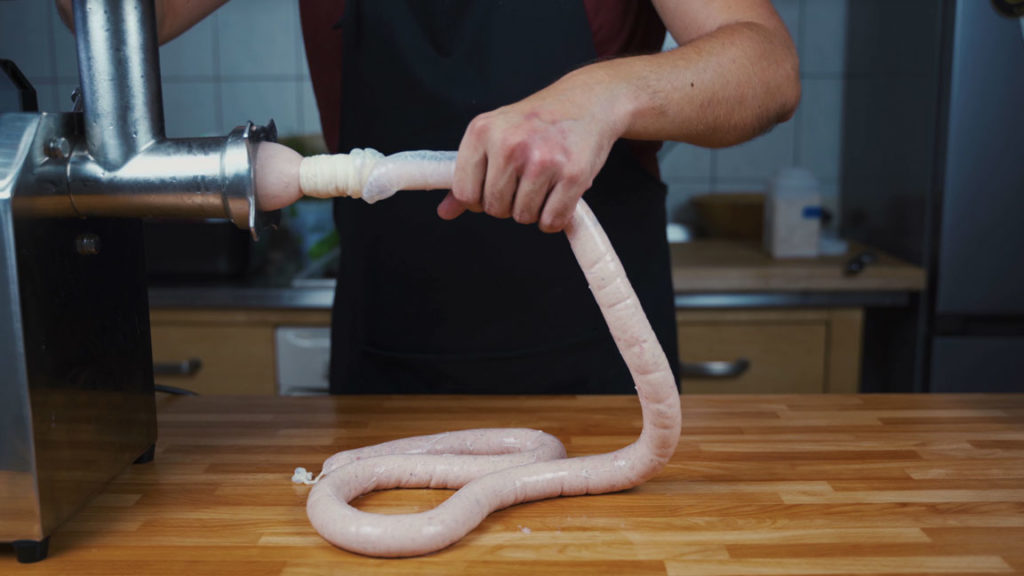
8. Now it’s time to link the sausages. You can decide for yourself how big your Thuringer should be. Put the sausage between your thumb and forefinger. Rotate the sausage away from you then move to the next link and rotate it toward you.
As with the filling process you will need some practice to get it perfect.
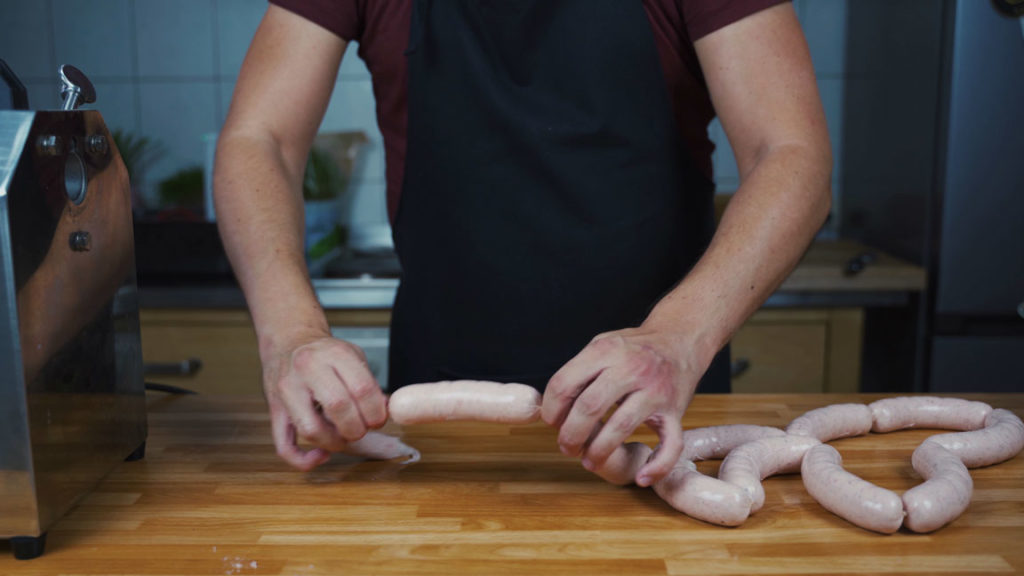
9. Your thuringer sausage is now ready. Fry it up and enjoy.
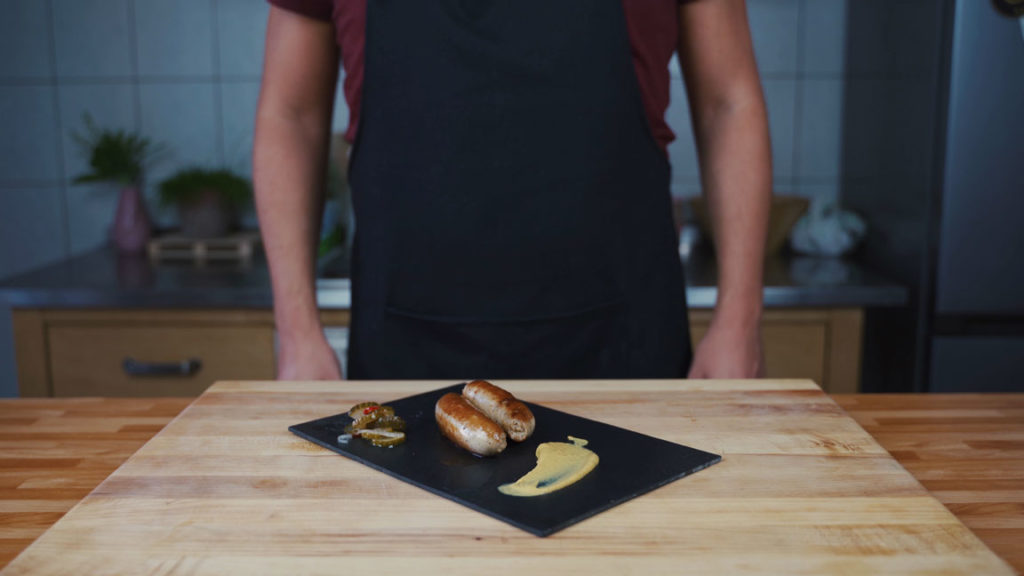
How long is the shelf life of the thuringer sausage?
Depending on how you handle it after production, the thuringer sausage has a different shelf life.
Raw, it can be kept in the refrigerator for about 1-2 days.
If you poach it directly after production at 75 °C (167 °F) for 25 minutes, it will keep for about a week in the refrigerator in an airtight package.
Alternatively, you can also freeze it raw or poached and it will keep for up to 6 months without losing any of its taste.
I usually eat the sausages directly or freeze them raw.
Making thuringer sausage without a meat grinder – Is this possible?
You would like to make your own thuringer sausage, but don’t have a meat grinder at home and don’t want to buy one?
The simplest way…
Just ask your trusted butcher if he can grind the pieces of meat for you.
Afterwards you have a finished basic mass and can add the spices and fill them in casings or preserve in jars.
3 additional Thuringer Sausage recipes
There is not THE ONE Thuringia and therefore I have added some more recipes here.
The respective origins are also linked but are in German.
Thüringer Bratwurst – Otto Valten (Stadtilm)
Meat per kg:
- 30 % veal
- 20 % lean pork
- 10 % pork backfat
- 10 % pork cheek
- 10 % pork belly
In addition, 0.6 – 1 egg and 100 ml milk per kg
Spices per kg meat:
Thüringer Bratwurst – Herbert Tatzel (Arnstadt)
Meat per kg:
- 50 % pork belly
- 50 % pork shoulder
Additional 2 eggs per kg and 100 ml milk. Breadcrumbs as required
Spices per kg meat:
- 18 g salt
- 2.5 g pepper
- 1 pinch of caraway
- 1 pinch nutmeg
- 1/4 clove garlic
Thüringer Rostbratwurst – Opa Jochen
Meat per kg:
- 35% pork shoulder
- 15% back fat
- 50% pork belly
Additional 14% crushed ice / ice water
Spices per kg meat:
- 18g salt
- 4g white pepper
- 1g ground caraway
- 3g caraway seeds crushed
- 2g nutmeg
- 4g cutter phosphate

Ok you’ve got my attention! Are all your recipes broken down like the samples you are describing.
Do you have recipes for cold smoked sausages and the use of curing salts , #1 & #2.
Hey Dale,
yes all recipes are broken down like this. Yes there will be cold smoked sausages in the future also sausages with cures. I already have some in my books if you want to take a look.
Cheers,
Daniel
Our group is planning to make a batch of Thuringer brats. I’m interested in trying your recipe. Can you please help me understand why you include Cutter phasphate as an ingredient for a fresh sausage.
Hey Ian, because of the binding. We add the crushed ice while chopping. No phosphates the liquid would seperate from the sausage later and it would be a disaster. All other binders, which are often used, are not as effective and have an impact on taste. Phosphates do not.
Used to get this wurst in Germany
It was long narrow and they grilled it after putting spices on the outside.
I was wondering what spices they rolled onto the wurst before grilling it.
Normally not rolled in spices. Must be something different or a regional twist somewhere.